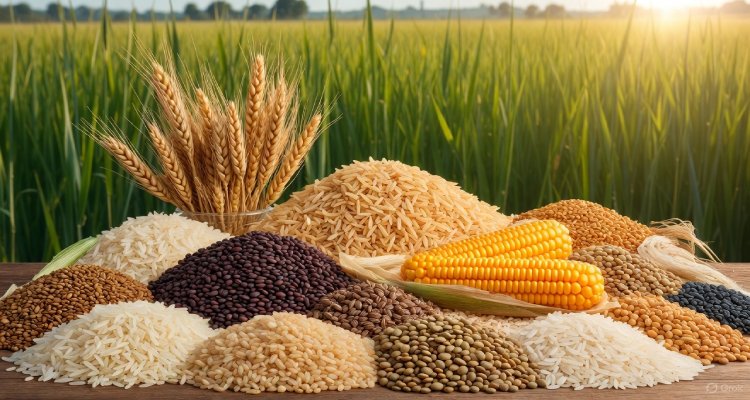India’s Foodgrain Output Hits Record High of 357.73 Million Tonnes: A Decade of Agricultural Growth
India’s foodgrain production for 2024–25 hits a record 357.73 million tonnes, marking an 8 percent rise driven by robust policies, higher MSPs, and farmer resilience.
Introduction: A Record Year for Indian Agriculture
India’s agricultural sector has achieved a landmark milestone. For the 2024–25 crop year, the nation’s total foodgrain output reached an unprecedented 357.73 million tonnes, reflecting an 8 percent increase compared to the previous year. The announcement by Union Agriculture Minister Shivraj Singh Chouhan on November 20 underscores India’s consistent progress toward food security and rural stability.
“The record production is a testament to the hard work of our farmers and the effective government policies that support them,” Chouhan noted while releasing the final estimates.
Context and Background: A Decade of Expansion
India’s rise in agricultural output is not a sudden achievement but the result of sustained growth and investment over the past decade. In 2015–16, the country’s total foodgrain production stood at 251.54 million tonnes. Within ten years, that figure has surged by more than 100 million tonnes, marking a 42 percent increase.
The growth reflects a mix of favorable monsoon patterns, expanded irrigation coverage, resilient hybrid seeds, and policy reforms that strengthened price support mechanisms. Government interventions through higher Minimum Support Prices (MSP), improved procurement systems, and technological assistance under schemes like PM-KISAN and PMFBY have reinforced farmer confidence across the country.
Main Developments: Wheat and Rice Lead the Surge
India’s foodgrain output has not only broken records at the aggregate level but also across individual crop categories. According to the government’s final estimates:
-
Wheat: Production touched 117.94 million tonnes in 2024–25, up from 113.29 million tonnes in the previous year.
-
Rice: Output rose to 150.18 million tonnes from 137.82 million tonnes in 2023–24, thanks to bumper harvests in eastern states and expanded paddy acreage.
-
Coarse Cereals: Production grew to 63.92 million tonnes, indicating increasing diversification toward millets—a priority under India’s “Shree Anna” initiative.
-
Pulses: Output climbed to 25.68 million tonnes, up from 24.24 million tonnes, ensuring better supply for domestic consumption.
Beyond foodgrains, oilseed production rose sharply to 42.98 million tonnes, driven by higher yields in soybean and groundnut regions. Sugarcane output also saw a marginal rise to 454.61 million tonnes, though cotton production dipped to 29.72 million bales compared to 32.52 million a year earlier, reflecting regional pest pressure and erratic weather conditions in parts of Maharashtra and Telangana.
Expert Insight: Policy, Technology, and Resilience
Agricultural analysts see this milestone as both an economic and social achievement. Dr. Anupam Verma, an agricultural economist at the Indian Council of Agricultural Research (ICAR), emphasizes that “the steady rise in foodgrain production has been powered by policy stability and the adoption of modern technology at the grassroots level.”
Experts point to digital integration in agricultural credit, precision farming, and the use of satellite-based yield assessments as critical tools that have reduced output variability. The push for climate-smart agriculture—through micro-irrigation, crop insurance, and soil health programs—has also boosted productivity while mitigating weather-related risks.
Importantly, the government’s focus on promoting pulses and oilseeds under the Atmanirbhar Bharat vision addresses long-standing import dependencies, encouraging crop diversification and price stability for consumers.
Economic and Social Implications
The record output holds multiple implications for India’s economy. Higher production ensures increased buffer stocks, stabilizing prices of staples like rice and wheat in the domestic market. This directly benefits both consumers and the government’s public distribution system (PDS).
For farmers, the rise translates to improved incomes, particularly under higher MSP levels and expanded procurement coverage. The current record could also reinforce India’s position as a dependable exporter of agricultural commodities, with rising global demand for rice, sugar, and millets.
However, the report also flags emerging concerns. The decline in cotton output signals the need for renewed focus on pest-resistant seeds and region-specific support. Additionally, as India’s population and consumption patterns evolve, maintaining sustainable productivity without overexploiting soil and water resources remains a key challenge.
The Road Ahead: Building on Success
Looking forward, India’s agricultural strategy is expected to emphasize technological modernization and climate resilience. The Ministry of Agriculture is advancing programs that integrate AI-driven farm advisories, drone-based spraying, and digital soil mapping to enhance efficiency and precision.
Policy experts also recommend diversifying beyond cereals toward horticulture, pulses, and high-value crops to meet nutrition goals and export opportunities. “India’s challenge is no longer only about producing more—it’s about producing smarter, sustainably, and profitably,” says Shivakumar Singh, a senior policy consultant at NITI Aayog.
As climate uncertainties rise, continued investments in irrigation infrastructure, regional research centers, and storage facilities will determine whether the next decade replicates this agricultural success story.
Conclusion: A Decade Defined by Growth
India’s achievement of a record 357.73 million tonnes of foodgrain production represents far more than a statistical accomplishment. It reflects the collective resilience of Indian farmers, the effectiveness of policy reforms, and the country’s growing self-reliance in food production.
As the agricultural landscape transforms through innovation and sustainable practices, the next goal is not just to sustain production levels but to ensure equitable growth that benefits every farming community. India’s record harvest, thus, stands as both an economic triumph and a promise of food security for future generations.
Disclaimer: This article is based on official data released by the Ministry of Agriculture, Government of India, and expert opinions available in the public domain. The content is for informational and educational purposes only.











